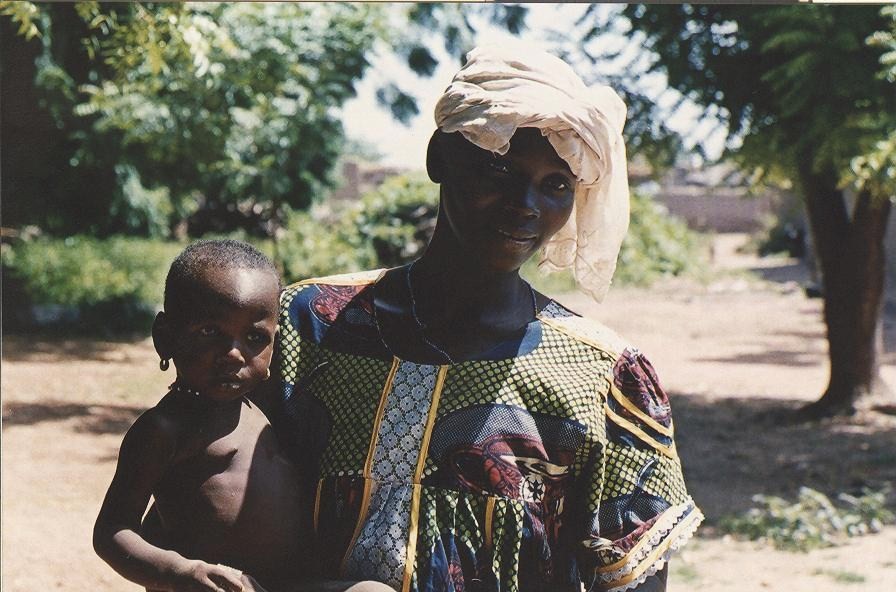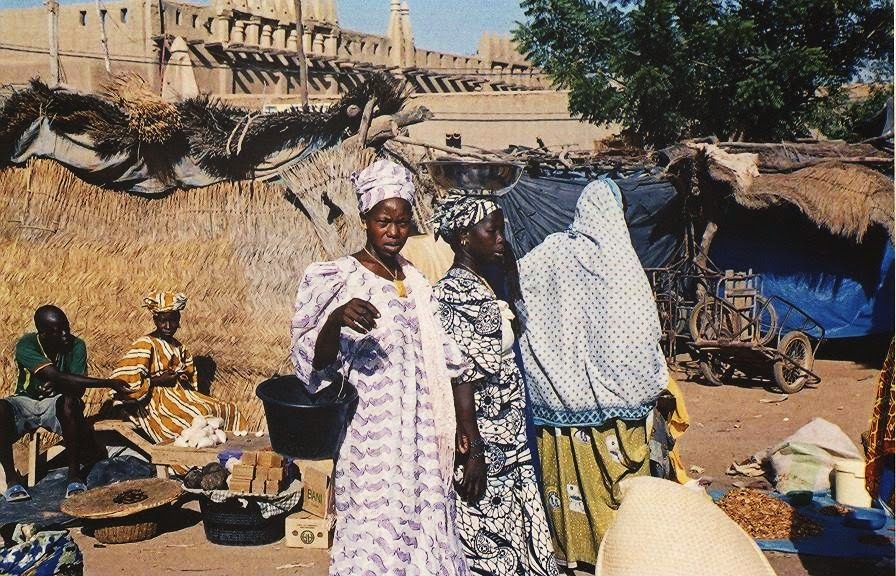Why Mali ? Because I had read that Mali is one of Africa's richest countries both culturally and historically (but unfortunately not financially) and its people are one of the warmest. Furthermore, I also knew there were several ethnic groups there that I wanted to meet : the Bambara, the Peul, the Bozo, the Songhai, the Dogon, the Touareg and even more, constituting a total population of 13 million. This does not seem much in a country almost twice as big as Turkey, but consider that two thirds of the country is a desert - the Sahara.
With a group of 6 other friends we thus set out to discover Mali. We flew via Paris and reached Bamako the capital . Bamako is one of these big cities you normally do not want to go to, but as it houses the only international airport in the country, you cannot skip it. As we arrived around midnight, we spent a night there and in the morning continued on to Djenné in two 4x4 Toyota Land Cruisers that would be with us until the end of our trip.
It is on the way to Djenné that we had our first glimpse of the Niger River, the lifeblood of Mali. The Niger has its source in Guinea, enters Mali in the southwest, flows past Bamako and Mopti, curves northwest to touch the southern edge of the Sahara near Timbuktu, then curves back to the southeast and over the border into Niger, before flowing south into Nigeria and finally to the sea, travelling for 4.180 km.
 |
| WE LEFT SO EARLY THE SUN WAS JUST RİSİNG ON THE NİGER. |
Djenné is 570 km from Bamako but luckily enough the roads were good and we could go fast. İt is during a stop on the way, in Fana, that I had my first contact with the people of Mali and especially the children. I have never seen such cute babies and lovely children so you will see a lot of them in this blog since I could not help myself from taking their pictures.
 |
| ME AND PEUL CHİLDREN. I ASKED OUR GUİDE KUNTA HOW HE KNEW THOSE CHİLDREN WERE PEUL, AND HAD THE BEST ANSWER EVER : ''FROM THEİR COLOR '' HE SAİD. AND HE WAS DAMN SERİOUS. |
 |
| A BEAUTİFUL PEUL WOMAN. |
 |
| ON THE LEFT, OSMAN, OUR DRİVER. ON THE RİGHT, KUNTA, OUR GUİDE. |
 |
| GET USED TO İT; İN AFRİCA CHİLDREN ARE ALWAYS CARRİED ON THE BACK AND GOODS ARE CARRİED ON THE HEAD LİKE THİS WOMAN SELLİNG BRACELETS. |
 |
| WE DİSEMBARKED FROM THE FERRY HERE. WE ARE ALMOST İN DJENNE NOW. |
The Great Mosque of Djenné is a classical Sahel-style building dating from 1907 , but the first building was erected on the same site in the 13th century. The 40 to 60 cm thick walls are made of sun-baked mud bricks and are coated with mud plaster to give them their smooth look. Bundles of palm branches stick out of the walls to reduce crackings caused by frequent drastic changes in temperature. Those also serve as ready-made scaffolding for annual repairs. Every year, the entire Djenné community takes an active role in the mosque's maintenance during an annual festival which includes music and food, but whose primary object is to repair the damage caused by erosion during the annual rains. Around 4.000 people plaster the mosque during this festival.
 |
| SAND AND MUD İN THE MİDDLE OF SAND |
 |
| THE THREE MİNARETS OF THE MOSQUE. |
We have come to Djenné on a Monday with the sole purpose of visiting the Djenné market as well and we were right since we saw what is considered one of West Africa's most colorful markets. On market days, the square in front of the mosque fills with vendors and shoppers. People of the various ethnic groups of Mali come together to sell and purchase everything from cattle , meat and fish to vegetables, rice and all sorts of household goods. So many colors; so much vibrancy; such cacophony; such crowds.... It is a huge market that has barely changed since the days when Saharan camel caravans brought salt across the sands to the gates of Djenné.
 |
| THE PRİNTS THE LADİES ARE WEARİNG ARE BEAUTİFUL. |
 |
| THE BABİES EVEN MORE SO |
 |
| PRETTY HAİRDO. |
 |
| THAT'S WHAT HAPPENS TO THE BABY WHEN THE MOTHER BENDS. |
 |
| THEY CARRY EVERYTHİNG ON THEİR HEADS SO COMFORTABLY |
 |
| PAY ATTENTİON TO THE DESİGN ON THE HAİR. |
We then decided to visit the old town of Djenné and by the look of it I decided that old Roman cities with their paved streets and water canals are more modern that Djenné was. It seems as if nothing has changed much here in the last 2000 years. The streets are covered with sand and earth, a dirty water evacuation system is non-existent and everything flows in the middle of the streets where children play. As it was nearly 45 degrees Celcius, let me not describe the odor. Finally I started feeling dizzy and hid in the shadow of a grocery shop to drink a whole bottle of ice-cold water. There is nothing like water to put you on your feet again.
After Djenné we set out to go to Mopti. We passed villages almost all of which had no electricity, and thus no television and I had the impression the only ''entertainment'' the villagers had in the evening was to make children since there seems to be millions of them around, running like bees towards the car, shouting ''cadeau, cadeau'' the moment the car stops.
On the way to Mopti we also stopped at a village called Sofara since there was a market and markets are the best places to mingle with local people. This one was also a very colorful market.
A VERY CONSERVATİVE MUSLİM WOMAN. THEY ARE RARE THOUGH.
I will finish Mali here since I have already written about the Dogon country and Timbuktu in two other posts.
I really enjoyed Mali. That is a country that is one of the poorest in the world but whose poeple are warm and friendly. Furthermore, Mali has a lot to offer since Djenné is a totally different world from the Dogon Country which itself is not Timbuktu at all. I saw interesting buildings, lots of color and adorable children. What more would I want.
From Mali we continued on to Burkina Faso about which I will write in my next post.












































